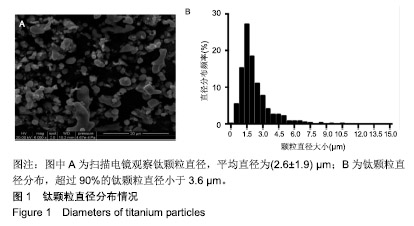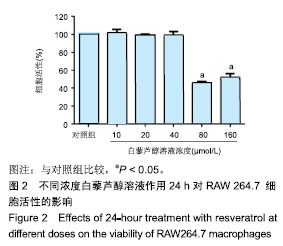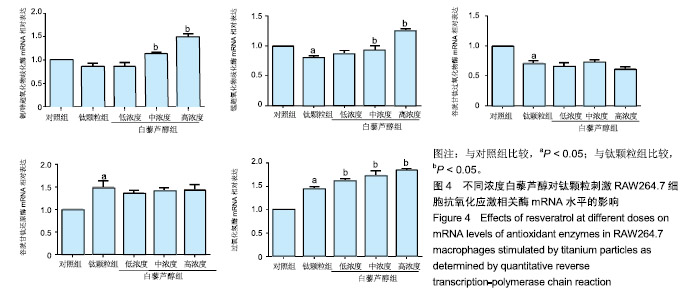| [1]Thiele K, Perka C, Matziolis G,et al.Current failure mechanisms after knee arthroplasty have changed: polyethylene wear is less common in revision surgery.J Bone Joint Surg Am.2015;97: 715-720.[2]Learmonth ID,Young C,Rorabeck C.The operation of the century: total hip replacement.Lancet. 2007;370(9597):1508-1519.[3]Inacio MCS,Ake CF,Paxton EW,et al.Sex and Risk of Hip Implant Failure Assessing Total Hip Arthroplasty Outcomes in the United States. Jama Intern Med.2013;173(6):435-441.[4]Purdue PE,Koulouvaris P,Potter HG,et al.The cellular and molecular biology of periprosthetic osteolysis.Clin Orthop Relat Res. 2007;454:251-261.[5]Goodman SB,Gibon E,Pajarinen J,et al.Novel biological strategies for treatment of wear particle-induced periprosthetic osteolysis of orthopaedic implants for joint replacement.J R Soc Interface. 2014;11(93):20130962.[6]Baur JA,Sinclair DA.Therapeutic potential of resveratrol: the in vivo evidence.Nat Rev Drug Discov. 2006;5(6):493-506.[7]Tennen RI,Michishita-Kioi E,Chua KF.Finding a Target for Resveratrol. Cell.2012;148:387-389.[8]Diaz-Gerevini GT,Repossi G,Dain A,et al.Beneficial action of resveratrol: How and why? Nutrition.2016;32(2):174-178.[9]Bitterman JL, Chung JH. Metabolic effects of resveratrol: addressing the controversies. Cell Mol Life Sci. 2015;72(8): 1473-88.[10]Momken I,Stevens L,Bergouignan A,et al.Resveratrol prevents the wasting disorders of mechanical unloading by acting as a physical exercise mimetic in the rat.FASEB J. 2011;25(10): 3646-3660.[11]Tresguerres IF,Tamimi F,Eimar H,et al.Resveratrol as anti-aging therapy for age-related bone loss. Rejuv Res.2014;17(5):439-445.[12]Wang HD, Shi YM, Li L, et al.Treatment with resveratrol attenuates sublesional bone loss in spinal cord-injured rats.Br J Pharmacol. 2013;170(4):796-806.[13]Zhao HF, Li XM, Li N,et al.Long-term resveratrol treatment prevents ovariectomy-induced osteopenia in rats without hyperplastic effects on the uterus.Br J Nutr.2014;111(5):836-846.[14]Kinov P, Leithner A, Radl R,et al.Role of free radicals in aseptic loosening of hip arthroplasty. J Orthop Res.2006;24(1):55-62.[15]Suh KT, Chang JW, Jung JS. The role of inducible nitric oxide synthase in aseptic loosening after total hip arthroplasty.J Bone Joint Surg Br.2002;84(5):753-757.[16]Kinov P, Tzoncheva A, Tivchev P. Evidence Linking Elevated Oxidative Stress and Aseptic Loosening of Hip Arthroplasty.Cr Acad Bulg Sci.2010;63:1231-1238.[17]Anderson JM, Rodriguez A, Chang DT. Foreign body reaction to biomaterials. Seminars in Immunology. 2008;20:86-100.[18]Nich C, Takakubo Y, Pajarinen J, et al.Macrophages-Key cells in the response to wear debris from joint replacements. J Biomed Mater Res A.2013;101:3033-3045.[19]Archibeck MJ, Jacobs JJ, Roebuck KA, Glant TT. The basic science of periprosthetic osteolysis. J Bone Joint Surg Am.2000 ; 82a:1478-1489.[20]Ren PG,Irani A,Huang ZN,et al.Continuous Infusion of UHMWPE Particles Induces Increased Bone Macrophages and Osteolysis. Clin Orthop Relat R.2011;469:113-122.[21]Huang ZN,Ma T,Ren PG,et al.Effects of orthopedic polymer particles on chemotaxis of macrophages and mesenchymal stem cells.J Biomed Mater Res A.2010;94a:1264-1269.[22]Yang F, Wu W, Cao L,et al.Pathways of macrophage apoptosis within the interface membrane in aseptic loosening of prostheses. Biomaterials. 2011;32:9159-9167.[23]Pajarinen J Kouri VP,Jamsen E,et al.The response of macrophages to titanium particles is determined by macrophage polarization. Acta Biomater.2013;9(11):9229-9240.[24]Fritton K, Ren PG, Gibon E, et al. Exogenous MC3T3 Preosteoblasts Migrate Systemically and Mitigate the Adverse Effects of Wear Particles.Tissue Eng Pt A.2012;18(23-24): 2559-6257.[25]O'Neill SC,Queally JM,Devitt BM,et al.The role of osteoblasts in peri-prosthetic osteolysis. Bone Joint J.2013;95-B(8):1022-1026.[26]Jiang YP,Jia TH,Gong WM,et al.Titanium particle-challenged osteoblasts promote osteoclastogenesis and osteolysis in a murine model of periprosthestic osteolysis.Acta Biomater. 2013;9: 7564-7572.[27]Ren WP,Markel DC,Schwendener R,et al.Macrophage depletion diminishes implant-wear-induced inflammatory osteolysis in a mouse model. J Biomed Mater Res A. 2008;85(4):1043-1051.[28]Ren PG, Huang ZN, Ma T,et al.Surveillance of systemic trafficking of macrophages induced by UHMWPE particles in nude mice by noninvasive imaging. J Biomed Mater Res A.2010;94(3):706-711.[29]Ren PG, Lee SW, Biswal S, Goodman SB. Systemic trafficking of macrophages induced by bone cement particles in nude mice. Biomaterials.2008;29:4760-4765.[30]Gibon E, Ma T, Ren PG,et al.Selective inhibition of the MCP-1-CCR2 ligand-receptor axis decreases systemic trafficking of macrophages in the presence of UHMWPE particles.J Orthop Res. 2012;30(4):547-553.[31]Mostardi RA, Kovacik MW,Ramsier RD,et al.A comparison of the effects of prosthetic and commercially pure metals on retrieved human fibroblasts: The role of surface elemental composition. Acta Biomater. 2010;6:702-707.[32]Del Buono A,Denaro V,Maffulli N. Genetic susceptibility to aseptic loosening following total hip arthroplasty: a systematic review. Br Med Bull.2012;101:39-55.[33]Gallo J, Mrazek F, Petrek M. Variation in cytokine genes can contribute to severity of acetabular osteolysis and risk for revision in patients with ABG 1 total hip arthroplasty: a genetic association study.BMC Med Genet.2009;10:109. [34]Pearl JI,Ma T,Irani AR,et al.Role of the Toll-like receptor pathway in the recognition of orthopedic implant wear-debris particles. Biomaterials. 2011;32(24):5535-5542.[35]Jamsen E, Kouri VP, Olkkonen J,et al.Characterization of macrophage polarizing cytokines in the aseptic loosening of total hip replacements.J Orthop Res.2014;32:1241-1246.[36]Lambeth JD, Neish AS.Nox Enzymes and New Thinking on Reactive Oxygen: A Double-Edged Sword Revisited. Annu Rev Pathol. 2014;9:119-145.[37]Sareila O, Kelkka T, Pizzolla A, et al. NOX2 Complex-Derived ROS as Immune Regulators. Antioxid Redox Signal.2011;15(8): 2197-2208. [38]Chen W, Li Z, Guo Y, et al. Wear particles promote reactive oxygen species-mediated inflammation via the nicotinamide adenine dinucleotide phosphate oxidase pathway in macrophages surrounding loosened implants.Cell Physiol Biochem.2015;35(5):1857-1867.[39]Chen WS, Li ZQ, Guo Y,et al.Wear Particles Impair Antimicrobial Activity Via Suppression of Reactive Oxygen Species Generation and ERK1/2 Phosphorylation in Activated Macrophages. Inflammation. 2015;38(3):1289-1296.[40]Tsaryk R, Peters K, Barth S,et al.The role of oxidative stress in pro-inflammatory activation of human endothelial cells on Ti6Al4V alloy.Biomaterials.2013;34(33):8075-8085.[41]Samelko L,Caicedo MS,Lim SJ,et al.Cobalt-alloy implant debris induce HIF-1alpha hypoxia associated responses: a mechanism for metal-specific orthopedic implant failure.PLoS One.2013;8: e67127.[42]Raghunathan VK, Devey M,Hawkins S, et al.Influence of particle size and reactive oxygen species on cobalt chrome nanoparticle-mediated genotoxicity. Biomaterials. 2013;34(14): 3559-3570.[43]Hallab NJ, Jacobs JJ. Biologic effects of implant debris. Bull NYU Hosp Jt Dis.2009;67:182-158. |
.jpg)






.jpg)